DinoFest 2018: Dinosaurs in Motion
In 2018, DinoFest and its lineup of expert speakers explored the movement of dinosaurs with our theme of "Dinosaurs in Motion." See a synopsis of each lecture and watch the recorded videos below.
Can't get enough DinoFest? Explore past years' themes and speakers here.
Dr. John Hutchinson
Dinosaur Movement: From Humble Beginnings to Earth-Shaking Giants
Keynote speaker Dr. John Hutchinson reviews his team's research on how dinosaurs moved and how their walking and running changed over time, from their distant quadrupedal ancestors to multiple origins of bipedal motion to major changes with evolving gigantism, flight, and more.
Professor Hutchinson loved dinosaurs as a kid like so many do, forgot that love as a teenager, then had his passion rekindled by reading and viewing “Jurassic Park” and taking science classes as an undergraduate in Zoology at the University of Wisconsin in Madison, finishing in 1993. He then went on to do a PhD in Integrative Biology at the University of California in Berkeley from 1995-2001 (with Prof. Kevin Padian and others), focusing on the evolution of dinosaur locomotion and anatomy. He spent two years as a mechanical engineering postdoctoral fellow at Stanford University nearby before departing the USA for a faculty job in the United Kingdom, where he has been since 2004; as a full Professor of Evolutionary Biomechanics since 2011. He has worked on hundreds of living and fossil species including dinosaurs, elephants, crocodiles and more; and has been featured in 14 science or nature documentaries including “T. rex Autopsy” and “Attenborough and the Giant Dinosaur” most recently.
Video Unavailable
Dr. Kathleen Ritterbush
Were Ammonites Fast Food?
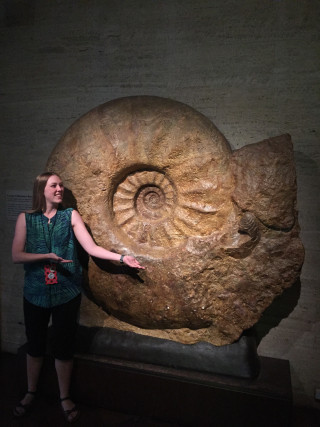
When dinosaurs ruled the earth, ammonites ruled the seas! These squid-like animals left a glorious record of spiral shells favored by fossil-lovers worldwide, but scientists still debate what the animals did with their time. The University of Utah’s own Dr. Kathleen Ritterbush in explores how shell shape might reveal which ammonites could dash, cruise, drift, and bob away from becoming lunch for the next passing ichthyosaur!
Dr. Kathleen Ritterbush is an Assistant Professor of Paleontology at the University of Utah. She started a science career teaching marine biology on boats and marine stations in California and Hawaii, then got a PhD studying how Jurassic sea life responded to a global mass extinction at the dawn of the dinosaur age. Her BS in Environmental Science is from Cal Lutheran, and PhD from University of Southern California. Her current field work is focused in the American West, Peruvian Andes, and Canadian Rockies, and she also runs a microscope and a hydrodynamics lab at the U.
Video Unavailable
Dr. Dan Chure
Tracking Ancient Animals in an Ancient Desert: Dinosaurs and Other Creatures of the Nugget Sandstone
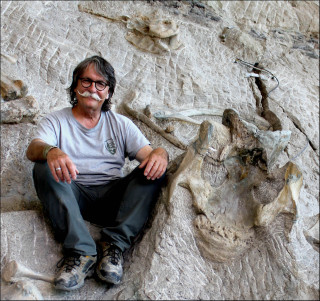
Join Dr. Dan Chure, recently retired paleontologist for Dinosaur National Monument, and discover how the western United States is home to some of the most mysterious fossils in the world. During the latest Triassic, this region was dominated by a vast sand dune sea. Although the environment was hostile, a surprising number of different groups of animals flourished in it. See and hear about the small mammal-like reptiles that left their marks including a cast of a 5 foot-long scorpion trail.
Dan Chure has had a passion for dinosaurs since he was a child. That obsession was fueled by visits to the American Museum of Natural History. His entire professional paleontological career (1979 – 2017) was spent as the paleontologist at Dinosaur National Monument where he oversaw the resource stewardship and science programs for the monument’s fossil resources. His research interests have focused on the evolution of dinosaurs and the ecosystems they lived in, public education about fossils, and the conservation challenges of in-situ fossil exhibits. For the last decade he has been working on the paleontology and paleo-environments of the great desert that covered the western United States in the Late Triassic.
Neffra Matthews
Fossil Footprint Sleuthing
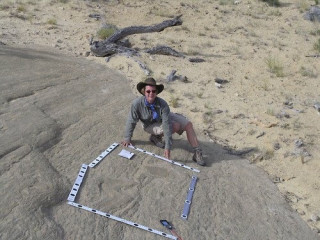
Neffra outlines how scientists combine forensic science and state-of-the-art 3D imaging to investigate fossil footprints left by dinosaurs in Utah and around the world. Learn what these tracks tell us about their environments, movement, behavior, and more.
Neffra Matthews has been involved in science and photography since childhood. Growing up in Kentucky, Neffra's father was an avocational geologist/paleontologist and her mother was a professional photographer. This combination of family interests influenced her education, career, and endeavors in paleontological resource documentation. Neffra has a M.S. in Geology from the University of Kentucky in Lexington and currently works for the BLM in Denver, Colorado. She has over 20 years of experience in photogrammetry and the geospatial sciences. Neffra has used photogrammetry to document fossil trackways and has made numerous presentations at professional conferences around the world.
Video Unavailable
Dr. Mark Loewen
Allosaurus in Motion: Bringing a Jurassic Predator to Life
Allosaurus was the quintessential predatory dinosaur of the Late Jurassic Period. Hear how NHMU’s own Dr. Loewen has brought this meat eater to life through reconstructions of the skeleton, muscles, and skin as well as reconstructions of its movements. From these paleontological clues we can begin to make predictions about how these animals interacted with each other and with other dinosaur in Utah’s Jurassic park.
Mark Loewen is a paleontologist at the University of Utah. He specializes in research on Jurassic and Cretaceous dinosaurs with an emphasis on the evolution and dispersal of meat eating, armored and horned dinosaurs; like Allosaurus, Tyrannosaurus, Ankylosaurus and Triceratops. He is currently Associate Professor Lecturer in Geology and Geophysics at the University of Utah and teaches the popular World of Dinosaurs and Natural Disasters classes. He conducts research on dinosaurs at the Natural History Museum of Utah where he is a Resident Research Associate. He is also affiliated as a research associate at the Denver Museum of Nature and Science and the Evolutionary Studies Institute at the University of the Witwatersrand. Mark received a master’s degree in paleontology from Loma Linda University and a doctorate in Geology from the University of Utah.
Dr. Paul Gignac
A Royal Appetite: HowTyrannosaurus rex Dined on the Bones of Cretaceous Dinosaurs
North American tyrannosaurids, including the giant theropod Tyrannosaurus rex, stand out from other large carnivorous dinosaurs for biting deeply into bones, pulverizing and digesting them. How T. rex was able to gain sustenance from large dinosaur skeletons has been a mystery—until now. Dr. Gignac explains how this unique carnivore was able to generate an 8,000 pound bite force and use repetitive dog-like biting to finely fragment and consume the bones of its prey.
Dr. Paul Gignac is a field paleontologist and an Assistant Professor of Anatomy and Vertebrate Paleontology at the Oklahoma State University Center for Health Sciences. He has excavated dinosaurs and other vertebrates from Mesozoic localities in Africa and North American, most recently hunting for polar dinosaurs from within the Arctic Circle on the North Slope of Alaska. His primary research interest is in the evolution of extreme performance, including the development and function of Nature’s most impressive feeding systems, like the snap-trap jaws of crocodilians and the bone-crunching teeth of their dinosaur relatives.
Dr. Stephanie E. Pierce
Fish out of Water: Did our Earliest Ancestors Walk onto Land?
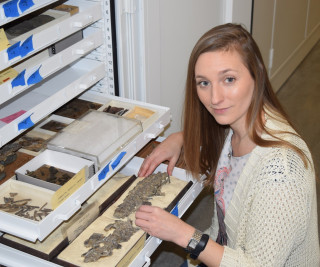
One of the great mysteries regarding the evolution of animals is how and when four-limbed vertebrates achieved the ability to stand and move on solid ground. Dr. Pierce outlines how new evidence suggests that our fish ancestors transitioned from swimming in water to walking on land at some point during their evolutionary history.
Dr. Stephanie E. Pierce is an Assistant Professor of Organismic and Evolutionary Biology and Curator of Vertebrate Paleontology at the Museum of Comparative Zoology, Harvard University. She received a BSc degree in paleontology from the University of Alberta, Canada (2000), a MSc degree by research in systematics and evolution from the University of Alberta (2003), and a PhD degree in paleobiology from the University of Bristol, UK (2008). Pierce’s research melds modern animal experimentation with computer generated models to examine the anatomy and movement of extinct vertebrate animals. A particular interest is reconstructing the locomotion behavior of the first terrestrial tetrapods as they transitioned from water-to-land. As part of this research, Pierce conducts fieldwork in North America with the aim to fill missing gaps in the early tetrapod fossil record. Her research has received worldwide media attention, being highlighted in the New York Times, National Geographic, Science, BBC, and Discover Magazine. She was featured in the award winning science documentary series Your Inner Fish, and was a scientific advisor on the award winning documentary series Inside Nature’s Giants. Recently, Pierce co-conceived, designed, and presented a series called Harvard Adventures! for the YouTube channel The Brain Scoop; the series details how paleontologists reconstruct the anatomy and movement patterns of extinct animals.
Video Unavailable
Dr. Casey Holliday
Sensational Skulls: How Tyrannosaurs and Crocodiles Bite so Hard
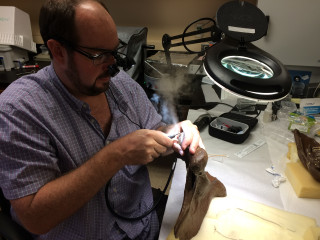
Although they know that tyrannosaurs and crocodilians can bite really hard, scientists are just beginning to understand how exactly these animals are capable of such powerful bites. Dr. Casey Holliday tours the internal anatomy of the heads of these amazing animals and learn how their jaw muscles, joints, cartilages, and other tissues help make such fascinating and dangerous skulls.
Dr. Casey Holliday is an Associate Professor of Anatomy at the University of Missouri. He employs imaging, anatomical and engineering approaches to understand how the bones, muscles, cartilages and other tissues work together to form the heads of birds, dinosaurs, crocodilians, and reptiles.
Video Unavailable
ReBecca Hunt-Foster
Tracking Dinosaurs in Southeastern Utah—A Real Jurassic Park
The remarkably extensive and abundant Jurassic-aged exposures on public lands around Moab have made this region well known for trace fossils. Many of these trace fossils are available for visitation by the public at interpreted sites throughout southeastern Utah. “Visit” some of these sites, discuss others, and hear from ReBecca how you can visit a real Jurassic park right here in Utah.
ReBecca Hunt-Foster is the District Paleontologist for the Canyon Country District of the BLM, located in southeastern Utah. ReBecca holds a Master of Science in Geology (emphasizing in Vertebrate Paleontology) from Texas Tech University, and has a Bachelor’s of Science in Earth Science from the University of Arkansas. Her current research includes Early Cretaceous ornithomimosaurs from North America, the Upper Cretaceous Williams Fork Formation paleofauna of western Colorado, the ichnofauna of the lower-middle Jurassic rocks of southeastern Utah. ReBecca has worked as a paleontologist in western Colorado and eastern Utah since 2007. Prior to moving to the area, ReBecca was a research assistant at Augustana College where she worked on latest Cretaceous ceratopsian dinosaurs from southern Laramidia and preparing Cryolophosaurus, the first known dinosaur from Antarctica.
Video Unavailable
Dr. James O. Farlow
Big vs. Bouncy: Body Size, Limb Proportions, and Relative Stride Length in Bipedal Dinosaurs
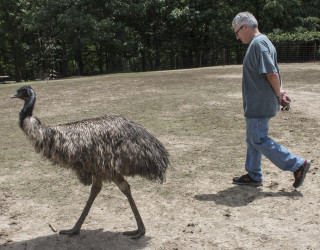
What information can researchers gain from a dinosaur track? Dr. James O. Farlow explores how dinosaur trackways give researchers insights into the size and stride length of dinosaurs as well as differences in their locomotion which can reveal valuable information about these animals.
James O. Farlow earned an undergraduate degree in zoology from Indiana University, and a PhD in geology from Yale University. For most of his career he taught courses in geology, paleontology, and oceanography at Indiana-Purdue University Fort Wayne (now Purdue Fort Wayne), where he is now an Emeritus Professor of Geology. Dr. Farlow’s research interests include functional morphology, paleobiology, and ichnology of dinosaurs and other archosaurs, and late Cenozoic vertebrates of Indiana. Farlow serves as editor of the Life of the Past book series for Indiana University Press.
Dr. Ashley Heers
Bird Wings on Dinosaur shoulders: a Musculoskeletal Model of Archaeopteryx, the First Bird
Join Dr. Ashley Heers and discover the origin of flight. Evolutionary transformations revealed by the fossil record are key to understanding the history of life. However, interpreting fossils can be difficult, especially when there is no existing organism to clearly compare them to. Dr. Heers explores these challenges through the use of a dynamic, 3D bone and muscle model of Archaeopteryx, the iconic “first” bird.
Ashley Heers is a postdoctoral researcher at Stanford University, interested in the development and evolution of locomotion. Using birds and their extinct dinosaur ancestors as a focal group, her research integrates biological, paleontological, and engineering disciplines to explore how developmental and evolutionary transformations in anatomy influence(d) locomotion during the invasion of new environments. Her goal is to elucidate the functional and ecological significance of rudimentary precursors to specialized locomotor structures such as wings—a long-standing challenge yet crucial understanding the vertebrate tree of life. She uses an arsenal of experimental, 3D visualization, and biomechanical modeling tools to achieve these goals.
Video Unavailable
Brent Breithaupt
Bringing the Flying Reptiles Down to Earth: Tracking Pterosaur Footprints using Photogrammetry
Photogrammetry, the science of making measurements from photographs, has been used to capture 3D data of tracks and trackways of pterosaurs and other dinosaurs by researchers for more than 20 years. Brent outlines how these data provide valuable information to better understand the terrestrial activities and behaviors of pterosaurs in the Jurassic West and around the world.
Brent Breithaupt is the Regional Paleontologist for the Bureau of Land Management (BLM) in Cheyenne, Wyoming, where he oversees BLM paleontology policy for the State of Wyoming and region (Montana, Idaho, Nebraska, North Dakota, and Idaho), as well as Alaska. He also is part of a national team that develops and implements policy for the preservation and protection of paleontological resources on BLM-administered lands, using scientific principles and expertise. Brent did his undergraduate work at the University of Wisconsin-Milwaukee and his graduate work at the University of Wyoming in Laramie. His research focuses on the history of vertebrate paleontology in Wyoming and the West, and the documentation and understanding of the Mesozoic Era vertebrate faunas. In addition, he has worked successfully with other colleagues to pioneer the use of photogrammetry (using stereo photography) for the state-of-the-art documentation of fossil footprints (especially dinosaur and pterosaur tracks) throughout the West. Along with Neffra Matthews, he has provided training on this technique to other geoscientists, both in the United States and Europe. Currently, this technology is being used throughout the world for the digital documentation of both trace and body fossils. Prior to his position with the BLM, he was the Curator/Director of the University of Wyoming Geological Museum, where he worked for 29 years. He is a strong proponent of public awareness, ethical practices, and partnerships in the field of paleontology.
Video Unavailable
Want More DinoFest?
If you've made it this far and are still craving more paleontology, then learn more about DinoFest here.
Or, check out our blog where you can find articles on paleontology and much more.